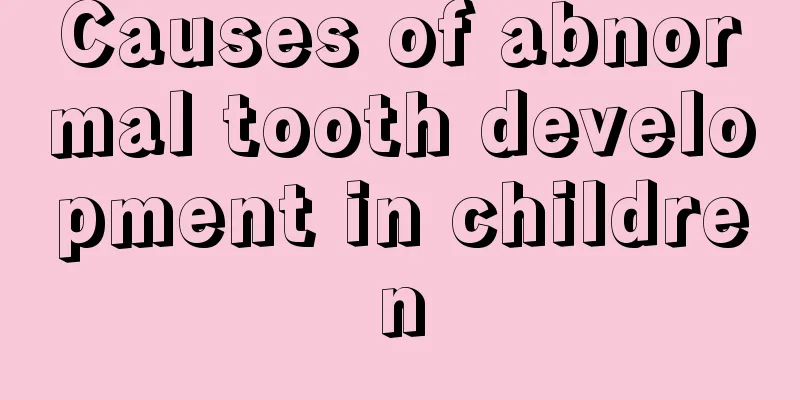Causes of abnormal tooth development in children

|
In fact, for their children, the development of teeth is a very critical thing for them, but many parents do not pay much attention to this situation, which will directly lead to abnormal development of children's teeth. Let us learn about the abnormal development of children's teeth. Abnormal situation: Causes The cause of the deformed central apex is unknown. It is currently believed that the pathogenesis of this lesion is that in the early stages of tooth development, the inner enamel epithelium of the enamel organ and the underlying mesenchymal cells proliferate or protrude deep into the tooth organ in a certain area. Clinical manifestations Deformed central cusps often occur in premolars, unilaterally or symmetrically, and there are reports of occasional occurrences in molars, canines, and incisors. The central apex of the deformity is often cone-shaped, about 2 mm high, mostly composed of enamel, and sometimes with a slender pulp horn extending into it. After the teeth erupt and establish occlusal relationship, the deformed central cusp is gradually worn away after occlusal contact, and secondary dentin is formed. Although the cusp is worn flat, the pulp remains normal and the root develops normally. Extra protruding tooth cusps on the occlusal surface may cause incomplete tooth eruption and tooth displacement; more commonly, as the occlusal surface is worn or the tooth cusps are broken, it may cause pulp exposure and infection. Senia and Regezi reported on the occurrence of periapical infection in non-carious premolars with malformed central cusps. Periapical infection often occurs during root formation, causing the root to stop developing, and appearing as a "trumpet-mouth" apical foramen on X-rays. Disease treatment (1) A malformed central cusp that is blunt and has good contact can be observed without treatment. (2) Reinforcement to prevent breakage: Clinical research reports show that in order to prevent the thin and pointed central cusp of a newly erupted tooth from breaking and becoming infected in the future, strong adhesives and composite resins can be used to reinforce the cusp. This allows the deformed cusp to undergo physiological wear along with the tooth, promoting the formation of secondary dentin at the pulp horn, and maintaining normal development of the pulp and root. (3) If pulp infection has occurred, endodontic treatment is required; for young permanent teeth, apex induction should be considered first, and then complete root canal treatment should be performed after the root has developed. (4) Teeth with insufficient root formation and severe periapical infection, or teeth with periapical lesions communicating with the gingival sulcus, should be extracted. The above article gives you a detailed introduction to abnormal tooth development in young children. I believe everyone has a relatively preliminary understanding. Therefore, in daily life, if your child has abnormal tooth development, you must correct it in time. |
<<: Treatment for white spots on baby nails
>>: Reasons why babies cry suddenly when they are asleep
Recommend
What are the symptoms of food poisoning in children?
Food poisoning often occurs in spring, and is mor...
Why do children clench their teeth at night?
Many children have the habit of being hyperactive...
How to treat atlantoaxial subluxation in children?
With the development of society, the incidence of...
Normal vision for a three-year-old child
The vision of a three-year-old baby is close to t...
What to do if your baby sleeps with the nipple in his mouth_ What to do if your baby sleeps with the nipple in his mouth
There are always some problems when feeding a bab...
Drugs for children's brain nutrition
When children are in the growth and development s...
What to do if your child has white spots on his arms
The white spots on children's arms may be vit...
How to make steamed eggs for 10-month-old babies
When the baby grows to a certain stage, it is nec...
What to do if your child's mouth is swollen
Children are relatively young, so they are very n...
What to do if your 8-year-old child is disobedient
As the saying goes, a child's future can be s...
How to deal with ulcers at the corners of children's mouth
As the saying goes, when a child is sick, the mot...
Why does a child have a runny green nose?
Everyone will inevitably have a runny nose. The m...
Bifidobacterium for neonatal jaundice
Neonatal jaundice is relatively common and is mai...
Why does the child's buttocks itch?
Generally speaking, children will definitely enco...
Can children with cerebral dysplasia be cured?
Brain maldevelopment in children is a relatively ...









